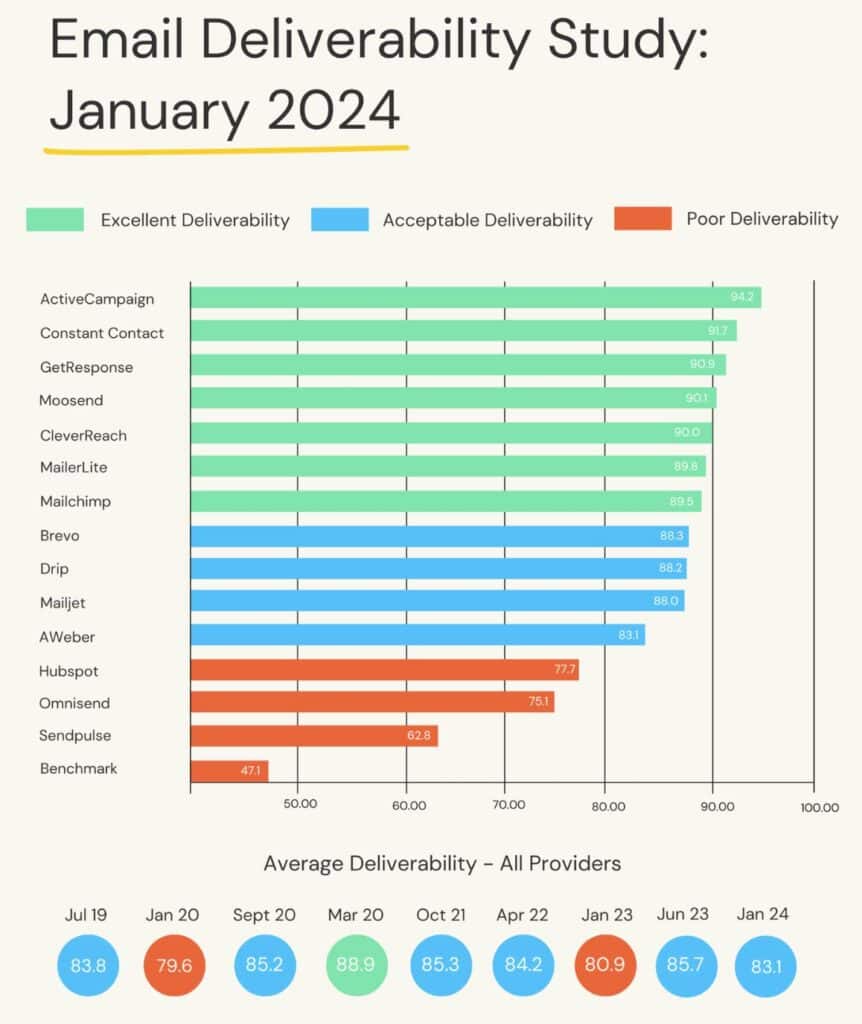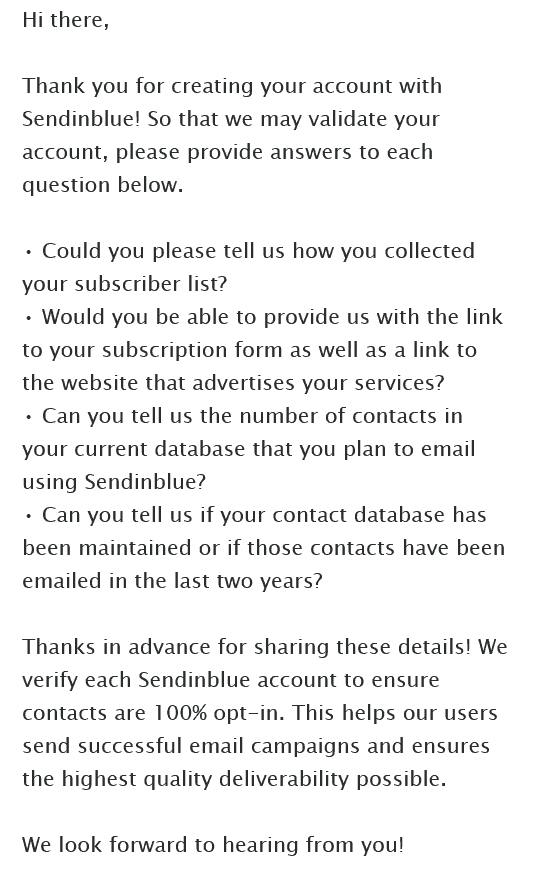Do your emails end up in the spam folder? Who is responsible for the deliverability? Is it you (the sender) or the email platform? While the sender is responsible for their sender reputation and deliverability, the email platform (ESP) plays a significant role in the sender's ability to enhance and maintain their deliverability. So, who bears the responsibility?
תוכן עניינים
Email deliverability
Twice a year, the website EmailToolTester compares the deliverability of different email platforms.
The method is similar: using the same domain and setting a sub-domain for each email platform. Sending the same email to a seed list that reports the location of the email: missing, spam, promotions tab, inbox.
For example, according to their report from January 2024, HubSpot, one of the most commonly used email platforms among startups, ends up with an unappealing score of “poor deliverability.”
Many other variables can influence deliverability in real life. The email platform is an essential factor, of course, but unlike other digital advertising tools, the platform does not do everything in email marketing, and the sender bears much responsibility for improving deliverability.
Is it possible to achieve better results than what was shown in the survey, even with the so-called “poor deliverability” platforms? Absolutely.
This brings us to the question: who is responsible for your deliverability?
Does the platform handle everything?
Many marketers heavily rely on advertising platforms such as Google or Facebook to manage all aspects of their marketing campaigns. They target their audience and then hit “send,” as the platform takes care of the rest. Many marketers lack a clear understanding of how email functions and differs from other channels. They often mistakenly assume that their Email Service Provider (ESP) is solely responsible for ensuring that emails reach their recipients’ inboxes.
When senders (customers of the ESPs) realize that their emails are being blocked or landing in spam (even though the ESP dashboard shows them as “delivered”), they immediately turn to the ESP and expect them to resolve the issue. But the situation is much more complex and the responsibility for their deliverability is shared between the ESP and the sender.
While senders have to take responsibility for their reputation and deliverability, the ESP also plays a crucial role in helping the sender improve and maintain their deliverability.
Who is responsible for your deliverability?
Marketing automation platform and email platform users are usually unfamiliar with the subject of deliverability or confuse it with another visible metric – delivery.
Subtracting failed-to-deliver emails from the total sent calculates the delivery rate. Deliverability is all about getting emails to the subscriber’s inbox, and it is very hard to measure.
Most deliverability issues are latent: they grow below the surface, and when they arise, it’s sometimes sudden and excruciating.
Since there is no deliverability dashboard in your ESP, it is common for existing deliverability issues to be overlooked.
However, deliverability issues, even if they are not visible in blood red, can significantly impact businesses as they lead to financial losses without the businesses even realizing there is an issue.
See also Can you find the hidden deliverability metrics in your ESP?
Knowing what you are buying
Deliverability is a mystery thing. Something that is hard to feel and measure.
Email service providers typically offer self-service tools for customers and prioritize a minimalist onboarding approach instead of providing personalized customer success. Only premium customers pay for hand glove onboarding and have consulting services at hand.
This is done without providing customers with sufficient knowledge and tools for dealing with deliverability and without warning them what the consequences of their mailing activity might be on deliverability.
Moreover, usually at the decision-making stage and comparing mailing systems, the customer is in contact with sales representatives who usually have no green idea about deliverability or who tend to sell the customer a dream and embellish the truth.
As a result, only customers who pay for expensive premium services that include accompaniment, extensive onboarding and setting up the mailing system (domain authorization, checking system settings, data handling, heating and more) enjoy an advantage that mostmarketeers do not receive.
From my experience with mailing and automation system providers, I think it’s entirely in their interest to help customers be good marketeers . Bad marketeersdamage the system.
At this stage, some mailing system providers are trying to retrieve a stone that someone threw a long time ago into the center of the lake, and getting it out of there is already a difficult task (the difference between smart and wise). There are mailing system providers that do not understand the issue of deliverability themselves, or their technological infrastructure is outdated, insufficient, not managed correctly, or is not suitable for the many changes that have occurred in the field of deliverability in recent years.
deliverability – two sides of the same coin
As stated, the responsibility for building and improving the sender reputation of the mailer belongs to the mailer himself (this is also in the financial interest of the mailer), but the mailing system has contributing responsibility and the ability to influence the success of the mailer in improving the deliverability.
This is why it is important to choose a deliverability-oriented mailing system provider or enter into a selection process with appropriate accompaniment.
Mailing system supplier responsibility
Because most of the mailing system’s customers use a common pool of IP addresses, email system providers suffer from “weak link syndrome”: the deliverability of their mailing system is measured by the worst mailer using their system.
In other words, a mailing system provider (ESP) needs to constantly monitor the quality ofmarketeers.
He should strive to teach marketeers how to build and manage mailing programs with best practice, and adopt a harsh policy towards problematic marketeers (get rid of them).
The problem is that most mailing system providers don’t…
Some mailing systems will manage their address pool in such a way as to “bounce” good marketeers to pool better addresses shared by good marketeers , as a result of which the goodmarketeers will enjoy better deliverability. Less good marketeerswill get a worse pool and will sometimes fire the problematic customers and try to solve specific problems with certain customers that it is worthwhile to keep in the portfolio.
Deliverability Questions You Should Ask a Mailing System Provider
- Do you “fire” customers who act like spammers and commit deliverability?
- How do you maintain my reputation as a mailer?
- What is your ability to alert me that I have deliverability issues?
- Do you have the ability to assist me with transgression issues?
- Do you have an internal or external deliverability team that can accompany me?
- Do you offer the option to sign my domain with SPF, DKIM and activate DMARC policies?
- Is the option to approve my domain self-service or do I need your assistance?
- Can you tell me the level of your deliverability to the major email providers (Gmail, Yahoo, Hotmail, Office 365)?
- What is the ratio of IP addresses to clients? (i.e. how many customers marketeers for each IP).
- What was the sender score of the IP address (or addresses) you assign to me in the last 12 months?
- Do you allowmarketeers who buy lists to email in your system?
- Do you check the sources of information of marketeers?
- Do you make sure that allmarketeers send emails only to recipients who have given consent (opt-in)?
- Do you have controls over the inbox placement of customers using your system?
- Do you have an information security certification or ISO?
When switching to a mailing system, you should expect a change in deliverability. This is usually a change for the worse for a short period of time.
If you follow proper mailing practices and help with appropriate professional guidance, yourdeliverability will improve over time.
See also Heating a domain in a mailing system
Mailing responsibilities
I often illustrate that proper mailing practices are like an orchestra having to learn to play in harmony. In one sentence: follow proper mailing practices and maintain a good Sender Reputation.
The term sender reputation is not just a description, but a metric by which marketeers are measured by email providers (MBP – Mailbox Providers) and spam filters. This metric depends on various factors, with the technological infrastructure of the mailing system being only one of the parameters (an important parameter).
Many marketeersprefer to get quick results and will do everything they can, without understanding the negative consequences of their actions to get quick results.
The outcome of this race is often the opposite – damage to your deliverability and those of your neighbors who use the IP address pool of the mailing system.
In order to reach a high level of deliverability, you probably need to forget everything you knew about email marketing and adopt other concepts by which your success as amarketeers will be measured.
What does it mean to be a good mailer?
Email starts with data: Who are the recipients on the list? What is the source of the data? How is the data collected? What is the quality of the data?
Did:
- Get to know basic concepts andmetrics in email marketing.
- Segment the recipient list (not saturated distribution).
- Build your mailing list organically, such as through website registrations.
- Email only to recipients who have given active consent to do so.
- Maintain hygienic lists (maintained list and no honey traps).
- Separate mailing activities in order to maintain reputation separately for each mailing sub-activity.
- Enable convenient removal from emails.
- Sending relevant content that will achieve high engagement.
- Beware of internal organizational pressures to achieve goals quickly while forgoing proper mailing practices, which can harm deliverability.
Don’t:
- Do not email to bought mailing lists.
- Do not email to lists collected on the Internet (scraping).
IP addresses
marketeers whose monthly volume of emails hover around a few hundred thousand emails on a regular and stable basis, who want to control their IP reputation, can consider switching to mailings under their fixed address (or number of addresses depending on their scope). This way, IP reputation is not divided between multiple marketeers. Sometimes the use of a static IP address of a particular space is affected by the reputation of the space itself of the ESP. See videos.
Points to consider
- Not all mailing systems allow you to work under a static IP address.
- Some mailing systems do not allowmarketeers to email under their domain while granting permissions to the domain (setting SPF, DKIM, DMARC records). This means that you have no ability to influence your reputation. See specifications here.
- Before switching to a new mailing system, check the existing documentation regarding the system (blogs, support articles) that exist on the editorial website. Also refer to the following article.
- Madware’s reputation is derived from many other parameters. between
- The rest are domain reputation, data quality, engagement and more.
אני סלע יפה, מומחה אימייל מרקטינג ועבירוּת אימיילים. אני מזמין אותך לפגישת יעוץ ראשונית של 1/2 שעה ללא עלות בנושא עבירוּת אימיילים ואסטרטגיית אימייל מרקטינג. book an email deliverability discovery call.
Further reading
What is the role of the mailing system provider (ESP) regarding deliverability?, Campaign Monitor
Basic concepts on email deliverability, Litmus
Correct Mailing Practices,Higher Logic
Expansion on liability for deliverability,digitaldoughnut
Can a mailing system guarantee 100% deliverability?, Oracle Blog
What is Sender Reputation

Sella Yoffe
Email Deliverability & Email Marketing Expert
Helping global email senders, startups, digital agencies, and ESPs with email deliverability, email authentication (SPF, DKIM, DMARC, BIMI), and email & content strategy
Podcast creator & Blogger @ CRM.BUZZ & EmailGeeks.Show







